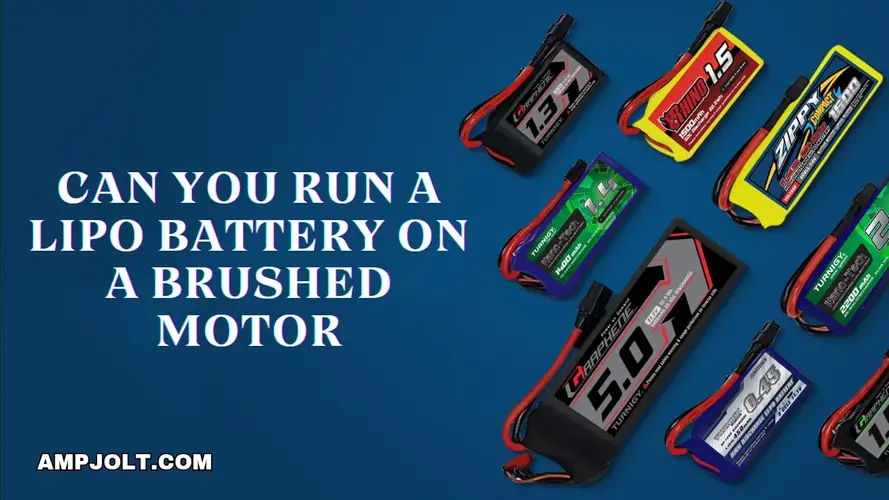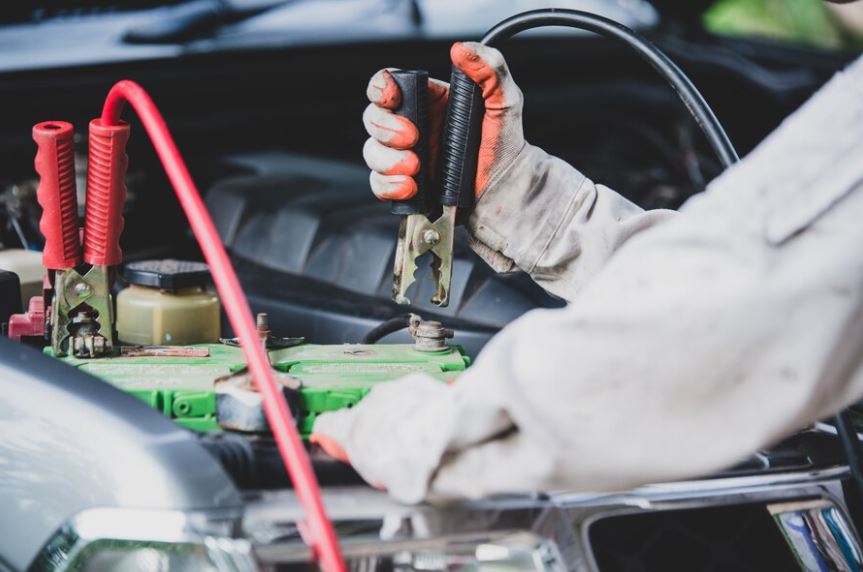What does an ideal Battery Energy Storage Site (B…
April 14, 2018

The world of remote-controlled vehicles, hobbyist projects, and various electronics applications often involves navigating the complex landscape of batteries and motors. One common question is whether you can run a LiPo (Lithium Polymer) battery on a brushed motor.
You can run a LiPo (Lithium Polymer) battery on a brushed motor. Ensure the LiPo battery voltage matches the motor's specifications, and consider factors like current draw, capacity, and temperature. Proper setup, including an Electronic Speed Controller (ESC) compatible with both components, is crucial for optimal performance and safety.
This comprehensive guide will delve into the intricacies of LiPo batteries, brushed motors, and the compatibility factors that influence their performance.
LiPo batteries have gained immense popularity for their high energy density, lightweight design, and ability to deliver consistent power. They are widely used in applications ranging from RC cars and drones to portable electronic devices. LiPo batteries consist of multiple cells, each providing a nominal voltage of 3.7 volts. Standard configurations include 2S (2 cells), 3S (3 cells), etc.
Brushed motors are a traditional type of electric motor that uses brushes and a commutator to control the flow of electricity. While brushless motors have primarily replaced them in many applications, brushed motors are still prevalent in specific devices due to their simplicity and cost-effectiveness. They operate on direct current (DC) and are commonly found in RC cars, boats, and industrial equipment.
The voltage rating of the LiPo battery should align with the voltage requirements of the brushed motor. Connecting a higher voltage battery to an engine designed for lower voltage can result in excessive speed and potentially damage the motor.
Brushed motors have specific amperage requirements. Ensuring the LiPo battery can supply the necessary current without exceeding the motor's limits is crucial. Using a battery with insufficient current capabilities can lead to performance issues and overheating.
LiPo batteries come in various capacities measured in milliampere-hours (mAh). The ability influences how long the battery can provide power. Selecting a LiPo battery with an appropriate capacity ensures sufficient runtime for the brushed motor.
The C rating of a LiPo battery indicates its discharge capability. It is critical for applications with high current demands, such as powering brushed motors. Ensure the selected battery has an adequate C rating to meet the motor's requirements.
LiPo batteries vary in size and weight, and the chosen battery should fit the available space in the device and align with weight restrictions. It's essential to balance power requirements with practical considerations.
Brushed motors often require an Electronic Speed Controller (ESC) to manage the current flow. Ensure the ESC is compatible with the brushed motor and the LiPo battery.

Determine the voltage, current draw, and any other specifications of the brushed motor. This information is crucial for selecting an appropriate LiPo battery.
Based on the motor specifications, choose a LiPo battery that matches the voltage, current draw, capacity, and C rating requirements.
Verify that the Electronic Speed Controller (ESC) is compatible with the brushed motor and the selected LiPo battery. Ensure that it can handle the voltage and current levels.
Connect the LiPo battery to the ESC and the ESC to the brushed motor. Follow the manufacturer's guidelines for proper wiring and connection.
Conduct a preliminary test to ensure the LiPo battery and brushed motor function correctly. Monitor temperature levels during operation to prevent overheating.
If the performance is not optimal, fine-tune the system by adjusting parameters such as gear ratios or modifying the setup based on the specific requirements of your application.
Avoid overcharging or over-discharging LiPo batteries, leading to performance degradation, reduced lifespan, and safety hazards. Use a reliable LiPo battery charger with built-in protection features.
Monitor the temperature of both the LiPo battery and brushed motor during operation. Excessive heat can indicate potential issues and should be addressed promptly.
Ensure that all wiring connections are secure and well-insulated to prevent short circuits, which can damage the battery and motor.
Adhere to the guidelines provided by the manufacturers of the LiPo battery, brushed motor, and ESC. This includes recommendations for voltage ranges, current limits, and any specific requirements for compatibility.
This may indicate an inadequate current supply. Check that the LiPo battery can meet the motor's current requirements.
Overheating can result from excessive current draw or mismatched components. Ensure the LiPo battery, motor, and ESC are compatible and within specified limits.
If runtime is shorter than expected, consider upgrading to a LiPo battery with a higher capacity to meet the energy demands of the brushed motor.
Inconsistencies may arise from poor connections or incompatible components. Double-check wiring and verify that all parts are compatible.
Preventing overheating when using LiPo batteries with brushed motors is crucial for ensuring the safety and longevity of your equipment. Here's a comprehensive guide on how to mitigate overheating issues:
Choose a LiPo battery that aligns with your brushed motor's voltage and current requirements. Refer to the motor specifications and ensure that the battery's capacity and discharge rate (C rating) meet or exceed the motor's demands.
Check the temperature ratings of both the LiPo battery and the brushed motor. Ensure that they can operate within a compatible temperature range. Working in extreme temperatures can lead to inefficiency and overheating.
Avoid exceeding the recommended voltage limits of your brushed motor. Connecting a LiPo battery with a higher voltage than the motor can handle may result in excessive heat generation and potential damage.
Calibrate the Electronic Speed Controller (ESC) correctly. Incorrect calibration can lead to excessive current draw and increased heat generation. Follow the manufacturer's guidelines for ESC calibration.
Ensure that the gear ratio between the motor and the load is appropriate. Incorrect gear ratios can lead to the engine working harder than necessary, causing overheating. Consult the manufacturer's recommendations for optimal gear ratios.
Provide sufficient ventilation for both the LiPo battery and the brushed motor. Ensure the equipment is placed in an area with good airflow, especially if enclosed in a casing or compartment. It would help if you also read Why does bike battery won't charge?
Keep an eye on the current draw during the operation. Excessive current interest can lead to increased heat production. If the motor consistently draws more recently than the battery can supply, consider upgrading to a higher-capacity LiPo battery.
Limit continuous high-demand usage, especially in applications that require prolonged periods of maximum power. Allow the system to cool down between intense sessions to prevent cumulative heat buildup.
Consider adding heat sinks or cooling fans to the brushed motor. These aids can help dissipate heat more effectively, especially during extended or demanding operations.
Regularly monitor the temperature of the LiPo battery and motor during operation. Stop the system if temperatures rise abnormally and investigate the cause. Conduct periodic tests to ensure consistent performance.
Avoid overloading the brushed motor with excessive weight or resistance. Operating the engine beyond its designed capacity can lead to increased heat production.
Ensure that all wiring and connections are secure and in good condition. Loose or damaged connections can increase resistance, leading to heat buildup.
Place the LiPo battery in a position that allows heat to dissipate efficiently. Avoid enclosing the battery in a space with limited airflow, as this can contribute to overheating.
Follow safety guidelines provided by the LiPo battery and brushed motor manufacturers. These guidelines often include recommended operating temperatures and precautions to prevent overheating.
Conduct regular maintenance on both the LiPo battery and brushed motor. Check for any signs of wear, damage, or inefficiency, and address issues promptly to prevent overheating.
Implementing these preventive measures and staying vigilant about monitoring and maintenance can significantly reduce the risk of overheating when using LiPo batteries with brushed motors. It ensures a safer, more efficient, and longer-lasting equipment operation.
Running a LiPo battery on a brushed motor is possible, considering voltage, current, capacity, and other compatibility factors carefully. By understanding the specifications of both the LiPo battery and brushed motor and following a systematic approach to setup and testing, enthusiasts and hobbyists can unlock the potential of this power combination for a wide range of applications. Remember to prioritize safety, adhere to manufacturer guidelines, and enjoy the enhanced performance and efficiency of LiPo batteries for brushed motor-driven devices.
Choosing a LiPo battery that matches the voltage, current draw, and capacity requirements of the brushed motor is crucial. Using an incompatible battery can lead to performance issues or damage.
Exceeding the voltage limit can result in excessive speed, overheating, and potential damage to the motor. Always select a LiPo battery that aligns with the specified voltage range of the brushed motor.
While possible, it's essential to consider the condition of the old LiPo battery. Aging batteries may have reduced capacity and performance. It's generally advisable to use a battery that is in good condition.
It's crucial to use a charger specifically designed for LiPo batteries. Chargers with built-in protection features help prevent overcharging and ensure the safety and longevity of the storm.
Motor stalling may indicate an insufficient current supply. Check that the LiPo battery can meet the current requirements of the motor, and consider upgrading to a battery with a higher current rating if needed.
Extreme temperatures can affect battery performance. Operating LiPo batteries within a moderate temperature range is advisable to ensure optimal efficiency and prevent potential damage.
Comments
Write a comment